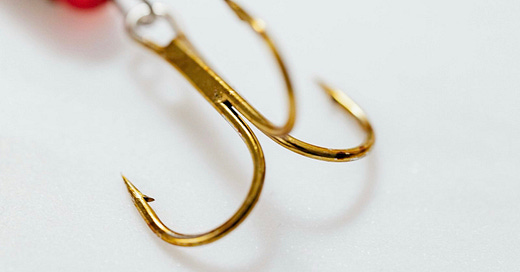Hooked by Nir Eyal, describes—often with a cautionary tone—how to hook people. One of my salient takeaways is if you want to hook, make things as frictionless as possible.
Using a simple inversion principle, intentionally raise the friction levels if you want to unhook yourself.
If social media is a cruel mistress, delete the apps from your phone. Only log in on your laptop—which you never leave logged in. The friction ante is upped even more if you don’t know your password off the top of your head or if you have 2FA set up.
If you are dieting or trying to reduce the consumption of a certain food or drink, keep it away from your eyeline. If you’re planning to do Dry January, don’t keep your favourite tipple at eye level in the fridge. Add some friction, such as not having it in the house, or at least have it stored so you don’t see the crisp bottle multiple times every day for a month.
If your YouTube usage gets out of hand and you feel inundated with the barrage of recommendations, search for your favourite channels from a logged-out or watch-history-off state. This adds significant friction to being pulled into the vortex of YouTube rabbit holes—where it’s been two hours and you’re wondering how on Earth you arrived at this video. You’d be surprised how few recommendations are meaningful or become go-to channels.
These approaches push towards intentionality. The added friction requires more intention and effort to achieve the ephemeral impulse. It also is likely to lead to higher feelings of control and feeling like the respective potential boons, in moderation, are used by you, for your benefit, rather than them using you and morphing into vices; the dose makes the poison.
“One of the most important things I ever did was to delete all those social media apps [from my phone],” remarked New York Times best-selling author, Robert Cheeke, on the Plant Fuelled Podcast. “I wasn’t controlling it. It absolutely controlled me,” he continues.
When Robert decided to unhook himself for 13 months, he reclaimed a tremendous amount of time; he went on mountain hikes, was more present, and wrote three books. “I was the most productive that I’d ever been.”
When he returned to social media he posted on his Facebook page to ask what he’d missed. The general consensus was not much or nothing. It seems more like JOMO than FOMO. Or perhaps most social media is so banal and unnourishing that it doesn’t even get classed as something to “miss out on”—a categorisation error.
Perhaps Robert’s social media usage was worse than normal, which may help explain the scale of the change. He explains that before the intentional unhooking, he’d often tune out of conversations and check his phone, and even felt compelled to look at his phone at red lights when driving his car. Yet, undoubtedly he wasn’t the only one who acted that way. Even if most individuals would only get some of the benefits Robert experienced, it seems an enticing proposal.
Greg McKeown suggests asking yourself “What would this look like if it was easier?” to make things effortless. This is great for many scenarios, including trying to ingrain good habits.
Ask yourself “What would this look like if it was harder?” to help you add friction and unhook.
Implementing an edifice of friction will increase the likelihood of inertia redirecting you away from re-hooking yourself. There are plenty more fish in the sea to be hooked—don’t join the rest of the shoal.





